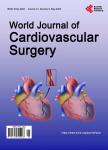Comparison of Cardiac Output Measurement by Noninvasive Method with Electrical Cardiometry and Invasive Method with Thermodilution Technique in Patients Undergoing Coronary Artery Bypass Grafting
Comparison of Cardiac Output Measurement by Noninvasive Method with Electrical Cardiometry and Invasive Method with Thermodilution Technique in Patients Undergoing Coronary Artery Bypass Grafting作者机构:Department of Cardiothoracic and Vascular Anaesthesia CN Centre VII Floor All India Institute of Medical Science New Delhi India
出 版 物:《World Journal of Cardiovascular Surgery》 (心血管外科国际期刊(英文))
年 卷 期:2014年第4卷第7期
页 面:123-130页
学科分类:1002[医学-临床医学] 100201[医学-内科学(含:心血管病、血液病、呼吸系病、消化系病、内分泌与代谢病、肾病、风湿病、传染病)] 10[医学]
主 题:Electric Cardiometry Thermodilution Pulmonary Artery Catheter Non Invasive Cardiac Output Thoracic Electrical Bioimpedance
摘 要:Objective: This study was conducted to compare the cardiac output by using Electrical Cardiometry (EC), a noninvasive method of continuous cardiac output monitoring during cardiac surgery with pulmonary artery catheter (PAC) derived cardiac output. Design: Prospective observational clinical study. Setting: Cardiac surgery operating room of a tertiary care cardiac center. Participants: Twenty five patients undergoing coronary artery bypass surgery with cardiopulmonary bypass. Measurements and Main Results: A total of 150 double data of cardiac output were compared with Thermodilution Cardiac Output (TDCO) and Thoracic Electrical Bioimpedance (TEBCO). The TDCO value ranges from 1.8-6.9 litre·min-1 with a mean of 4.39 ± 1.16 litre·min-1 and TEBCO ranges from 1.8-7.1 litre·min-1 with a mean of 4.21 ± 1.16 litre·min-1. The averaged Bland-Altman analysis for TDCO and TEBCO revealed that a mean bias was 0.18 and limit of agreement was -1.25 - 0.89 litre·min-1 and the percentage error (PE) ranged from 22%-32%. The precision for the TDCO was measured to be ±16.2% and the precision for TEBCO was ±19.6%. Receiver Operating Characteristic (ROC) curve analysis between TDCO and TEBCO with a cutoff of 15% shows a sensitivity of 84% and specificity of 63 and area under ROC curve of 0.80. Mountain plot between TDCO and TEBCO shows that a median percentile is 0.25 and value of 97.5 percentile is 1.525. Conclusions: The present study indicates that the electric cardiometry device yields numerically comparable results to cardiac outputs derived from the PAC during the cardiac surgery. Therefore, electrical cardiometry can be used to evaluate haemodynamic variables with clinically acceptable accuracy, when invasive methods are to be avoided or not available.



